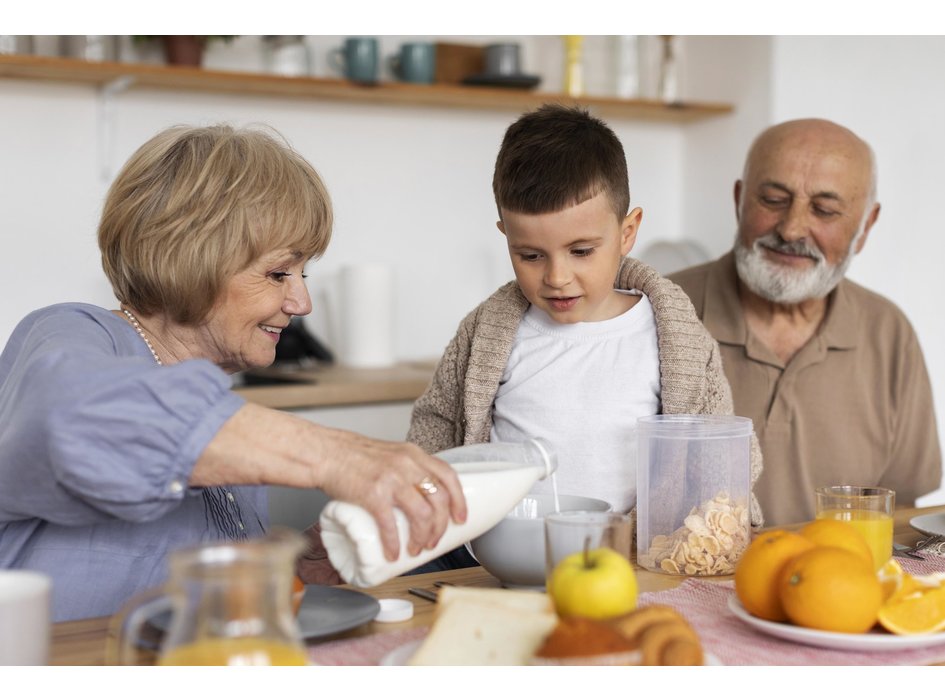Obsah
-
Why do we need nutrition "adapted" for the elderly? Are ordinary foods not enough?
For these reasons, nutritional supplements can be a solution - there are three types of products:
What are the most important nutrients in foods adapted for the elderly?
What foods are suitable for the elderly?
What foods can evoke positive emotions in older people?
Do foods for older people have to meet specific requirements?
Conclusion
With increasing age, we observe changes in lifestyle due to a decrease in physical capacity or the development of mental state. These factors can cause a decrease in physical activity, a reduction in food intake, sarcopenia (progressive loss of muscle mass and function), osteopenia (reduced bone mineral density) and osteoporosis (thinning of the bones). 2, 3
It is therefore necessary to provide adapted food for the elderly in order to cover specific nutrient requirements. An American statistical study from 2018 revealed that a healthy lifestyle (good eating habits, moderate alcohol consumption) could prolong life - for men by 12.2 years and for women by 14 years (while the average life expectancy of Slovaks in 2020 was 74.3 year). 4, 5
Why do we need nutrition "adapted" for the elderly? Are ordinary foods not enough?
Ordinary foods should, of course, remain part of the diet. However, many studies show that food intake decreases significantly with age. 2, 6, 7, 8
At the age of 20-80 years, energy intake decreases by about 600 kcal for women and by up to 1,300 kcal for men. This represents a reduction in energy intake of up to 50% - with such a decrease, the organism will not be left without consequences (reduction of cognitive and physical abilities, increase of fatigue, weakening of immunity, etc.). It is proven that the quality of life of older people is directly related to their eating habits. 9, 10
For these reasons, nutritional supplements can be a solution - there are three types of products:
- Nutritional supplements - are useful in supplying vitamins, minerals and other essential nutrients (including Omega-3 fatty acids or isoflavones against osteoporosis for women). The main disadvantage of these supplements is that they can be difficult for some older people to swallow, may be considered medicines, and some aversion may be observed.
- Functional foods - These are foods that are at first glance similar to conventional but contain one or more health-promoting nutrients. For example, protein drinks enriched with vitamins, minerals, trace elements, enzymes, they can also be porridge, puddings, desserts, soups and the like. 11
- "Maškrty" - these are traditional foods, but their shape and consistency can be consumed anywhere and at any time during the day (without the need for dishes or cutlery, comfortable for older people, even Parkinson's disease is not an obstacle). They are mostly a source of energy and essential nutrients.
What are the most important nutrients in foods adapted for the elderly?
Due to the fact that the energy intake of older people is often insufficient, foods intended for this population supply energy. Mostly in the form of fats, as fats are the most energetic macronutrient (carbohydrates and proteins have about 4 kcal in 1 gram, while fats are 9 kcal in 1 gram).
In terms of lipid quality, Omega-3 essential fatty acids are ideal, of which there are very few in the normal diet. Various studies have shown that increased consumption of Omega-3 reduces the risk of stroke as well as decreased cognitive ability. 9, 12, 13

In addition to fats, proteins are also very important for the older generation - they help maintain bone and muscle health. If the bones and muscles are in good condition, the body will retain its physical capacity. Anabolic resistance also comes with increasing age. In other words, a small amount of protein is not enough to stimulate muscle synthesis. It is advisable to eliminate this phenomenon by supplying more essential amino acids. It is also important to realize that food alone is not enough: physical activity (even walking!) Is essential to maintain muscle stimulation. 14
Essential amino acids are those that the body cannot synthesize or store. Therefore, they must be supplied with food.
Leucine is the most important essential amino acid to support anabolism (muscle protein synthesis). A dose of leucine of 2-3 g represents the minimum for stimulating muscle synthesis in the elderly. 14, 15, 16, 17, 18
Micronutrients are also important because their deficiency can pose a health risk. Vitamin D, vitamin B12 and calcium deficiency is common, so it is common to add them to foods for the elderly.
What foods are suitable for the elderly?
Not all foods are ideal for the elderly - not for health reasons, but simply do not like the elderly. As we already know, appetite often decreases with age, so foods for this category must be as tasty as possible for an older person to want to consume them. 7
A 2008 study in the Journal of Nutrition Health suggests that the more negative emotions food creates (resistance, indifference, worries, doubts, frustration, disappointment, fatigue), the greater the risk of malnutrition. It is therefore necessary to choose foods that create positive emotions. 19

What foods can evoke positive emotions in older people?
A 2006 study shows that the older generation loves the food they know with traditional cooking. So let's forget about complicated methods of preparation and non-traditional exotic dishes. Flavors should be familiar and classic - vanilla, chocolate, caramel, coffee ... In addition, sensory abilities weaken with age, so more pronounced flavors and aromas are more appropriate. 20
Do foods for older people have to meet specific requirements?
In addition to the nutritional and taste aspects, these foods must also have a certain shape and structure. Older people may suffer from certain diseases (eg dysphagia - a disorder of food transport from the mouth to the stomach, xerostomia - a reduction in the amount of saliva in the mouth), so the texture of the food is important. A food consisting of smaller bites is suitable so that it can be taken easily and without cutlery.
Conclusion
In order for food to be perfectly adapted to the elderly, it should be:
- Energy content of basic nutrients, especially vitamins (D, B12), minerals (calcium) and proteins (leucine). Therefore, milk protein cocktails are very interesting and suitable.
- Attractive and evoke positive emotions. Not too extravagant, because the elders prefer food that is well known to them.
- Easy to consume, with a suitable texture and shape (not too hard or too dry).
__________________________________________________________________________________________
RESOURCES:
[2] Sonya Brownie, “Why Are Elderly Individuals at Risk of Nutritional Deficiency?,” International Journal of Nursing Practice 12, no. 2 (2006): 110–18, https://doi.org/10.1111/j.1440-172X.2006.00557.x.
[3] Alfonso J. Cruz-Jentoft et al., “Prevalence of and Interventions for Sarcopenia in Ageing Adults: A Systematic Review. Report of the International Sarcopenia Initiative (EWGSOP and IWGS),” Age and Ageing 43, no. 6 (November 1, 2014): 748–59, https://doi.org/10.1093/ageing/afu115.
[4] “Indicateurs de Développement Dans Le Monde – Google Public Data Explorer,” accessed August 30, 2020, https://www.google.com/publicdata/explore?ds=d5bncppjof8f9_&met_y=sp_dyn_le00_in&idim=country:USA:GBR:CAN&hl=fr&dl=fr#!ctype=l&strail=false&bcs=d&nselm=h&met_y=sp_dyn_le00_in&scale_y=lin&ind_y=false&rdim=world&idim=country:USA&ifdim=world&hl=fr&dl=fr&ind=false.
[6] J. E. Morley, “Decreased Food Intake With Aging,” The Journals of Gerontology Series A: Biological Sciences and Medical Sciences56, no. Supplement 2 (October 1, 2001): 81–88, https://doi.org/10.1093/gerona/56.suppl_2.81.
[7] Anna Pilgrim et al., “An Overview of Appetite Decline in Older People,” Nursing Older People 27, no. 5 (June 2015): 29–35, https://doi.org/10.7748/nop.27.5.29.e697.
[8] Lorenzo M. Donini, Claudia Savina, and Carlo Cannella, “Eating Habits and Appetite Control in the Elderly: The Anorexia of Aging,” International Psychogeriatrics 15, no. 1 (March 2003): 73–87, https://doi.org/10.1017/S1041610203008779.
[9] Riccardo Calvani et al., “Current Nutritional Recommendations and Novel Dietary Strategies to Manage Sarcopenia,” The Journal of Frailty & Aging 2, no. 1 (2013): 38–53.
[10] Thara Govindaraju et al., “Dietary Patterns and Quality of Life in Older Adults: A Systematic Review,” Nutrients 10, no. 8 (July 26, 2018), https://doi.org/10.3390/nu10080971.
[11] karine Pierre-Lecocq, “Aliment fonctionnel,” CERIN, accessed April 9, 2020, https://www.cerin.org/glossaire/aliment-fonctionnel/.
[12] Institute of Medicine (US) Food Forum, Nutrition Concerns for Aging Populations, Providing Healthy and Safe Foods As We Age: Workshop Summary (National Academies Press (US), 2010), https://www.ncbi.nlm.nih.gov/books/NBK51837/.
[13] Natalia Ubeda, María Achón, and Gregorio Varela-Moreiras, “Omega 3 Fatty Acids in the Elderly,” The British Journal of Nutrition 107 Suppl 2 (June 2012): 3, https://doi.org/10.1017/S0007114512001535.
[14] Benoit Smeuninx et al., “Age-Related Anabolic Resistance of Myofibrillar Protein Synthesis Is Exacerbated in Obese Inactive Individuals,” The Journal of Clinical Endocrinology and Metabolism 102, no. 9 (July 14, 2017): 3535–45, https://doi.org/10.1210/jc.2017-00869.
[15] Imanipour Vahid et al., “The Effects of Branch-Chain Amino Acids on Fatigue in the Athletes,” Interventional Medicine & Applied Science 10, no. 4 (n.d.): 233–35, https://doi.org/10.1556/1646.10.2018.10.
[16] Joshua C. Anthony et al., “Orally Administered Leucine Stimulates Protein Synthesis in Skeletal Muscle of Postabsorptive Rats in Association with Increased EIF4F Formation,” The Journal of Nutrition 130, no. 2 (February 1, 2000): 139–45, https://doi.org/10.1093/jn/130.2.139.
[17] Christos S. Katsanos et al., “A High Proportion of Leucine Is Required for Optimal Stimulation of the Rate of Muscle Protein Synthesis by Essential Amino Acids in the Elderly,” American Journal of Physiology. Endocrinology and Metabolism 291, no. 2 (August 2006): E381-387, https://doi.org/10.1152/ajpendo.00488.2005.
[18] Hope Barkoukis, “Nutrition Recommendations in Elderly and Aging,” The Medical Clinics of North America 100, no. 6 (November 2016): 1237–50, https://doi.org/10.1016/j.mcna.2016.06.006.
[19] Issa Narchi et al., “Emotions Generated by Food in Elderly French People,” The Journal of Nutrition, Health & Aging 12 (February 1, 2008): 626–33, https://doi.org/10.1007/BF03008273.
[20] M. Laureati et al., “Sensory Acceptability of Traditional Food Preparations by Elderly People,” Food Quality and Preference, The First European Conference on Sensory Science of Food and Beverages: “A Sense of Identity,” 17, no. 1 (January 1, 2006): 43–52, https://doi.org/10.1016/j.foodqual.2005.08.002.

